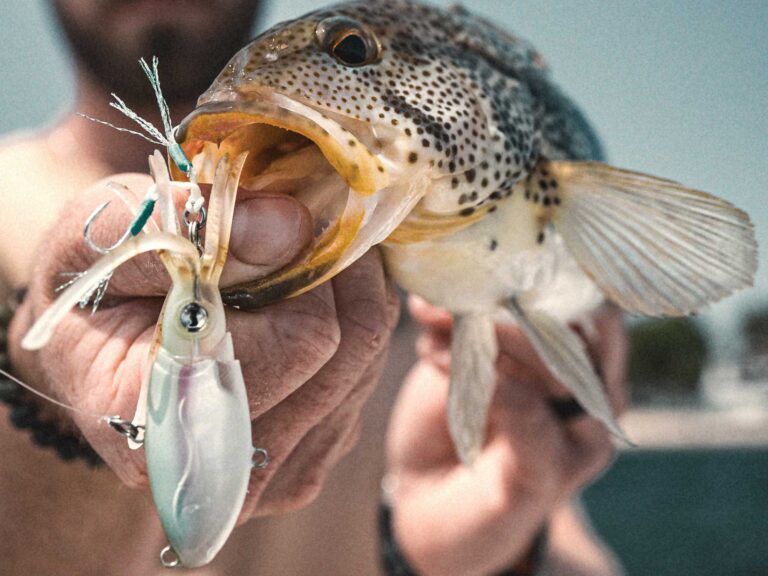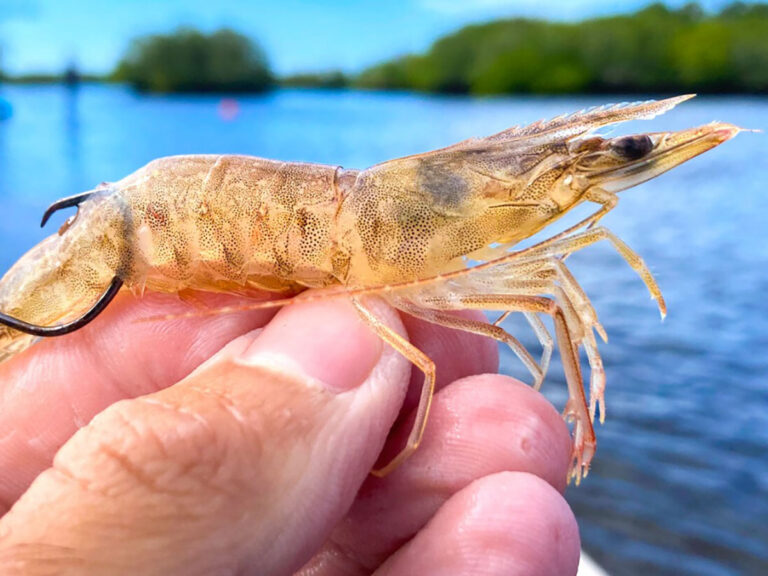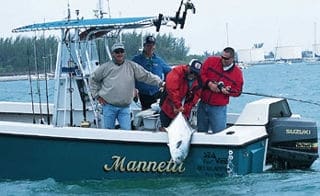
| Key West Harbor is one of the most dependable spots to catch permit, especially during the spring. This fishery is a great option for those who lack the time or patience to pursue these fish on the flats. Permit use their broad sides to create dogged resistance in any depth. |
Mention the word “permit” to a fly or light-tackle fisherman and he will likely conjure up visions of a deep-bodied, silver fish ghosting over white-sand flats. When sought in shallow water, permit are among the most difficult of fish to catch, often traveling alone or in pairs and frequently shunning all but the most carefully presented lures and baits. Their skittishness on the flats is notorious, with the slightest shadow or sound causing them to bolt for the nearest channel.
Such qualities have helped make the permit an illustrious and somewhat intimidating target among the light-tackle crowd. Indeed, many anglers have come to regard them as virtually uncatchable except by those with enough time, money and patience to pursue them. Therefore, it often comes as a surprise to learn that it’s possible to catch permit-big ones too-with great consistency and minimal expense by seeking them in slightly deeper water.
The Florida Keys is one of the best places in the world to catch permit, a fact that wasn’t lost on early pioneers of the sport. In McClane’s Game Fish of North America, the late, renowned Al McClane notes, “The permit is the rarest game fish in the world purely in terms of how few are caught, as opposed to how many anglers cast to them.” However, he goes on to say that, “A permit hooked in deep water near one of the Key West wrecks is not as spectacular as one taken in shallow water, but the dogged play of a 20- or 30-pound fish is exciting at any depth, and to say that you have ‘caught one’ is an angling distinction in itself.”
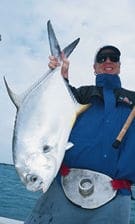
Permit use their broad sides to create dogged resistance in any depth.|
Multi-Faceted Fish
The same fish that so often turns its nose up at a well-placed fly or jig on the flats may hit almost anything when feeding over wrecks or reefs. One day, while fishing with Captain Joe Alexander on a wreck off Key West, I saw what I thought was a school of small amberjack swimming around the structure and flipped a Hopkins spoon out ahead of them. Three of the fish immediately broke away from the pack to chase after the shiny metal lure before one of them nailed it. After several minutes, I got my first sight of the fish and was amazed to see that my “amberjack” had broad, silvery sides and a small mouth-not the features normally possessed by a predator that chases after baitfish.
While I don’t advise throwing metal lures for permit, jigs work very well over the wrecks and reefs. That point was proven almost 30 years ago when the late Harry Ross and I fished with Captain Gene Montgomery on a shallow wreck off the Marquesas Keys, west of Key West.
Our skipper had only been able to obtain a small supply of live crabs, and we took turns throwing them to three schools of permit that were circling the wreck. Surprisingly, the fish were rather fussy, and several casts were required to produce a strike.
With the crabs almost gone, Montgomery suggested I try a bonefish jig. As soon as the jig began to move, three permit broke away from the school to chase it down! This happened time after time until Montgomery and I decided to call it quits and pursue another species.
The 50-Pound Permit
In 1949, author Phillip Wylie summed up the knowledge of the time nicely in his Game Fish of the World by noting, “The permit, which grows to 40 pounds, is a pompano with bonefish habits, propensities, and speed-graduated upwards according to his weight. He is usually taken in somewhat deeper water-two or three feet-and often on hard white coral bottom.”

A small, live crab hooked through the tip of the carapace is standard fare for the permit.|
We now know that permit grow well over 50 pounds and that they can be found in many different habitats. There’s no disputing the fact that stalking permit on the flats is the most exciting way to catch them, but wrecks, reefs and channels are the places to fish if you’re looking for quantity.
Even piers and surf zones have been known to produce some huge specimens. McClane, who touted Burroughs Cay in the Bahamas as the likely site of a future world-record permit and who once ventured to Sri Lanka in search of huge fish, was humbled when a new world record of 51 1/2 pounds was decked on a Lake Worth pier only ten miles from his Palm Beach home! That record has since been eclipsed by yet another pier catch-a 561/8-pounder taken off Fort Lauderdale in 1997 by Thomas Sebestyen.
Permit Paradise
The most consistent permit fishery in the world exists in the Florida Keys, and Key West is probably the single most reliable place to catch one throughout most of the year. Even flats fishing can be dependable in February and March unless it’s blowing a gale or a cold front settles in for a day or two. It’s a rare day indeed when you don’t see permit on the flats to the west during that time, and if you can get out to the Marquesas, there should be no question about getting good shots at fish of all sizes.
There’s a lot less fishing pressure in the fall, and the permit can be just as thick. Decades ago, I fished the Marquesas with Captain Cal Cochran from Marathon. I hooked a permit in the 25-pound class on the inside of the islands, only to have a houndfish cut my line as it was zipping through the water.
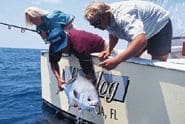
Key West may be permit central, but other Keys spot excellent action. This fish was taken over the wreck off Islamorada.|
My frustration in the Marquesas continued on a later trip with Captain Harlan Franklin. After releasing a small permit earlier in the day, I hooked a big one. I fought it for 15 minutes, only to have the hook pull out, something that rarely occurs due to the permit’s tough, rubbery lips.
Spring in the Keys provides an ideal opportunity to catch permit the really easy way-by bottom fishing in protected Key West Harbor. While not a sure thing, lots of permit are taken in the famed harbor tarpon fishery that’s based on the use of shrimp-boat bycatch, also known as “trash.” Key West guides are friendly with the shrimpers, who often bring their bycatch back to the harbor in exchange for a six-pack or two. If no boats are coming in, guides often run 20 miles or more into the Gulf in order to obtain chum from the shrimpers. The so-called trash contains a fascinating mix of crabs, mantis shrimp and various odd fish, including the mojarra that are favored for tarpon bait. In the lexicon of the Key West guides, “fishy trash” is tops for tarpon, while “crabby trash” is preferred for permit.
It’s often possible to hook permit while chumming for tarpon at any of the usual harbor spots simply by dropping a small jig tipped with a dead crab to the bottom. Joe Alexander uses a 5/8-ounce jig baited with a small crab when the tide is running, but as slack approaches he rigs his crabs on a plain hook and sends them to the bottom with an 1/8-ounce slip sinker. The trick is to use just enough weight to keep the crab on the bottom as you slowly jig it up and down. Keep in mind that permit are adept at sucking in a crab and leaving you with an empty shell if you’re not quick enough. If it feels like you’re getting hung up, that’s the time to set the hook!
Permit in the harbor and channels tend to bite best at the beginning and end of the tide, when the current isn’t steaming. That’s a good thing, because permit are virtually immovable once they position their broad bodies against a heavy current. Guides often drop off their anchors in order to drift back on the fish during the fight, just as they do with 100-pound tarpon.

Towers off Key West often serve as home to large schools of permit. Angler Don Smith succeeded in landing this bruiser by keeping it away from the tower legs.|
The Permit Patch
An even more dependable permit fishery occurs in April and May on the reef off Key West. There seems to be relatively little scientific information about permit, but Key West guides feel that the spring run on the reefs has to do with spawning activity. Whatever the reason, the number of fish found on the reef at this time is often staggering. Of course, there’s a lot more fishermen pursuing them these days, which has made the fishing tougher, but a few years ago it was common for guides to quickly put their customers on dozens of fish per day at the aptly named “Permit Patch” at Western Dry Rocks.
That sort of action is still available at times, especially when most of the competition is off fishing for something else. Guides are sometimes able to cruise among the coral heads in 38 to 50 feet and spot permit in the clear water before casting live crabs to them. The same sight-fishing technique is used by large charter boats at Islamorada, farther north in the Keys. There, skippers circle over shallow ocean-side wrecks and spot permit before directing the mate or angler where to cast their crab baits.
The key to fishing the Permit Patch, as in the harbor fishery, is to chum with shrimp-boat trash. Breaking up the crabs with a mallet is especially effective, and permit can often be chummed within sight. Casting or even dropping a small live crab back to the fish usually brings an instant response. The numerous coral heads result in lots of break-offs, but even 12-pound test is enough to turn a hooked fish away from the bottom. If you can fight the fish straight up and down, your chances of avoiding a cut-off improve greatly.
Permit have great endurance, and it’s important to apply maximum pressure at all times, making them work for every inch of line. Average-size permit can be fought at anchor, but when the occasional big one shows up it’s wise to buoy the anchor and try to get over the fish before it crosses a coral head or another boat’s anchor line.
It’s not often that anything will outfish a small live crab for permit, but it happens. I ran into this situation at the end of April last year while fishing with Gene Graman and Jay Smith on Joe Alexander’s Joe Green. The skipper didn’t like what he saw at the Permit Patch, so he kept running west to a tiny wreck in about 50 feet of water.
| Learner’s Permit_There are dozens of guides operating out of Key West and vicinity who can put you on permit. Small-boat guides generally run speedy 25- to 28-footers and aren’t afraid to burn fuel in order to find fish. To contact Captain Joe Alexander, who runs the Joe Green out of Oceanside Marina on Stock Island, call (305) 294-0639. For the names and numbers of other Keys captains who offer permit trips, turn to “The Traveling Fisherman” section in the back of this magazine. Larger charter boats don’t normally fish for permit, but in Islamorada just about all take advantage of sight-fishing for them over shallow wrecks in the spring._ |
Shortly after I lowered the anchor, permit started flashing in the chum line; however, they wouldn’t touch the dead crabs we drifted back. That’s not unheard of, but a switch to the “sure thing”-a live crab-didn’t work either. After some experimenting, we were able to hook up regularly by using mantis shrimp picked out of the trash.
Summer Sensation
As Gulf waters continue to warm in late spring, permit begin moving onto the wrecks in 60 feet of water or less and stick around until the first northeaster of fall. Alexander notes that local knowledge is vital, not only for locating the wrecks, but for knowing which ones hold permit.
After anchoring alongside (not over) a wreck and getting the permit turned on with chum, the surest way for a novice to hook up involves dropping a small live crab to the bottom and letting it sit there with the rod in a holder and the drag engaged. Permit will frequently hook themselves; however, the angler must be quick to grab the rod and power the fish away from the wreck.
Most permit pros prefer to chum the fish up and drop dead crabs to them, keeping live crabs in reserve. To be sure, there are days when permit can’t be located on the Gulf wrecks or will refuse everything offered to them (especially when Gulf waters are discolored after strong winds), but the odds should be in your favor. Wreck permit generally run from ten to 25 pounds, and most anglers are content to seek other species after catching one or two on 12-pound spinning gear. Fly-rodders can also score once the fish are turned on to chum.
There’s nothing quite like the challenge of finding permit in skinny water, delivering the perfect cast and watching the fish take your bait, fly or lure. But permit are great game fish no matter where or how they’re caught, and those anglers who lack the time, money or interest to spend days on the flats should take advantage of the relatively sure shots at hooking up-and no place offers better opportunities than Key West!
| # The Real Meal Deal |
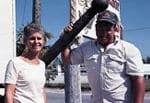
At the Rusty Anchor, Patty and Ramon Rodriguez serve up super-fresh seafood at reasonable prices.|
Like so many other agreeable places, Key West has become crowded in recent years. Hotels are booked, rental cars are hard to come by and restaurant lines are long. In this town, non-tourists (i.e., residents) have to live and get around, business as usual. Locals stay on the back roads and establish hideouts that are kept as secret as the wine of Santa Vitoria.
One such sanctuary is the Rusty Anchor, located next to the commercial fishing harbor on Stock Island. Locals say that if you can’t get a call back from your contractor, priest, lawyer, real-estate agent, doctor or girlfriend, drop by the Rusty Anchor at lunchtime. Others will tell you that there is more Key West business transacted at the Rusty Anchor between noon and 2:00 p.m. than during the entire rest of the day.
Located a scant four miles out of Key West, the Rusty Anchor is as down-to-earth as the members of the Rodriguez family, who own and operate what may well be the best seafood restaurant in the Keys. Ramon Rodriguez, his wife Patty, and daughter Trish are second-generation Key West restaurateurs with tight connections to the local commercial fishing fleet. They know their fish and understand that there is only one way to serve it-as fresh as it can possibly be.I’ve walked the prep kitchen and coolers with Ramon early in the day and watched Grade A fish being offloaded from local day boats just into harbor. The product is kept in superb condition and beautifully handled from the start. Fish, crabs, lobster, shrimp and conch are caught locally, buried deep in ice and prepared meticulously for that day’s meals. Fish are cut on-site, and sauces and condiments are made at the restaurant.
Ramon learned the restaurant trade from his father, who ran Rods, a well known Duval Street fish house next to the old shrimp basin. Around 1981, Ramon and Patty set out on their own and opened the Rusty Anchor on Stock Island. In the beginning, Ramon recalls, they would often trade shrimp for beer at their 30-seat bar that boasted ten small tables. Today, the Anchor’s 150-seat dining room turns over several times a night, and many a customer heads home with a full stomach and money still left in his wallet.
A trademark of the Rusty Anchor is value. You get a big portion of very good food for an amazingly small amount of money. Sure, you can order twin lobster tails with a steak and hurt your credit card if you want, but stick with the specials and baskets and it has to be one of the greatest restaurant values anywhere. The fried grouper is probably the best I’ve ever eaten, and the stone crabs are second to none. While fish is the mainstay of the menu, the steaks, burgers, ribs and conch are great too.
The Rusty Anchor is located on 5th Avenue on Stock Island. They take reservations for six or more, are closed on Sundays, and can be reached at (305) 294-5369. And don’t forget to visit the fresh fish market behind the restaurant.






